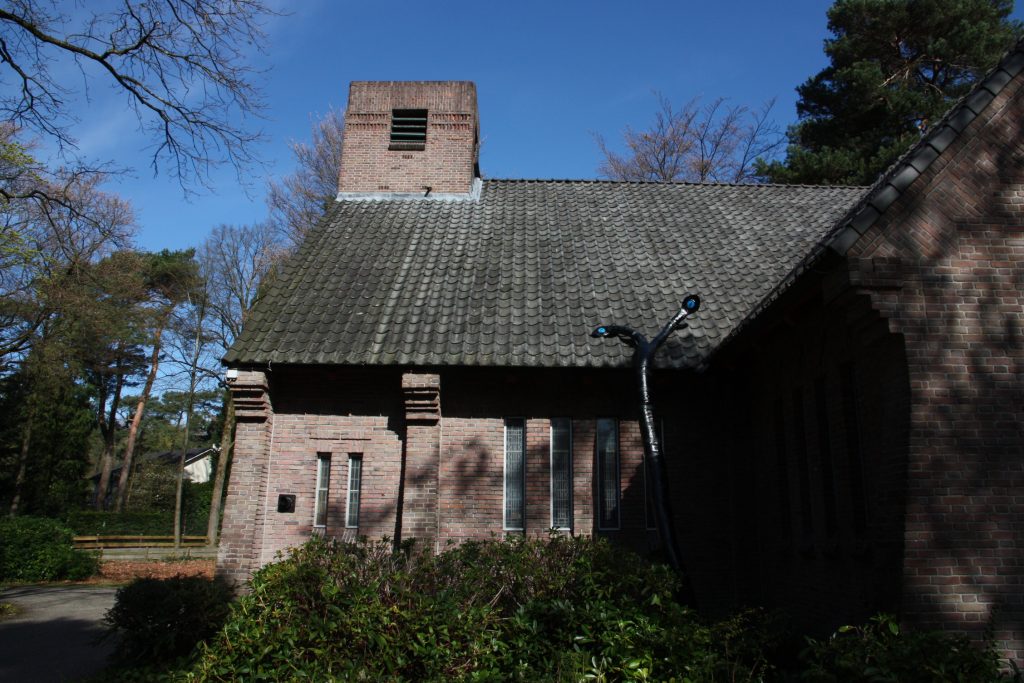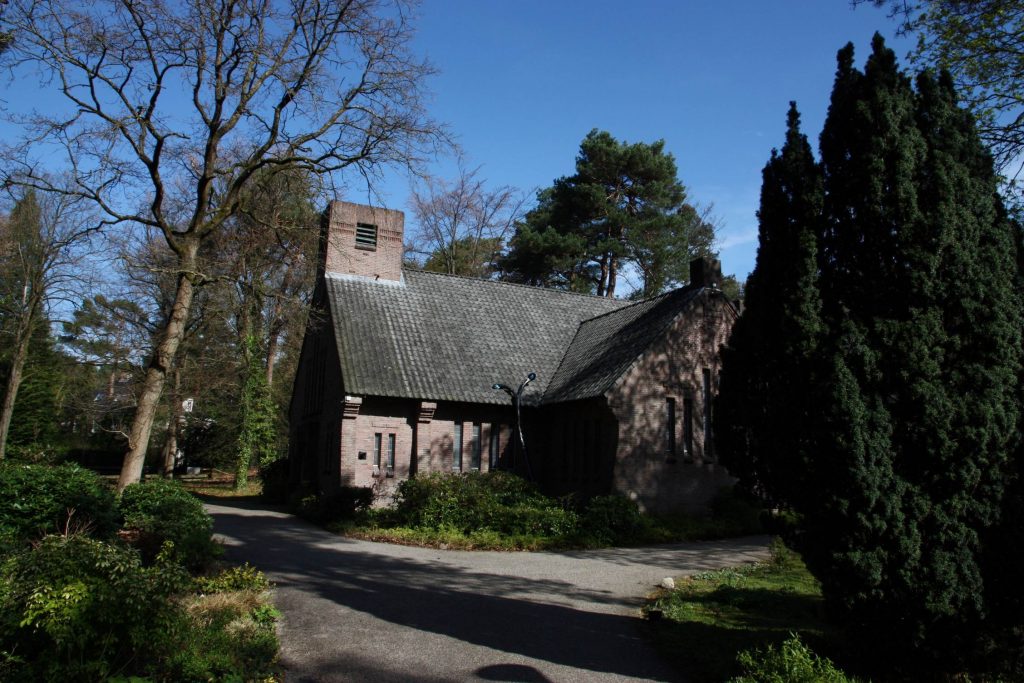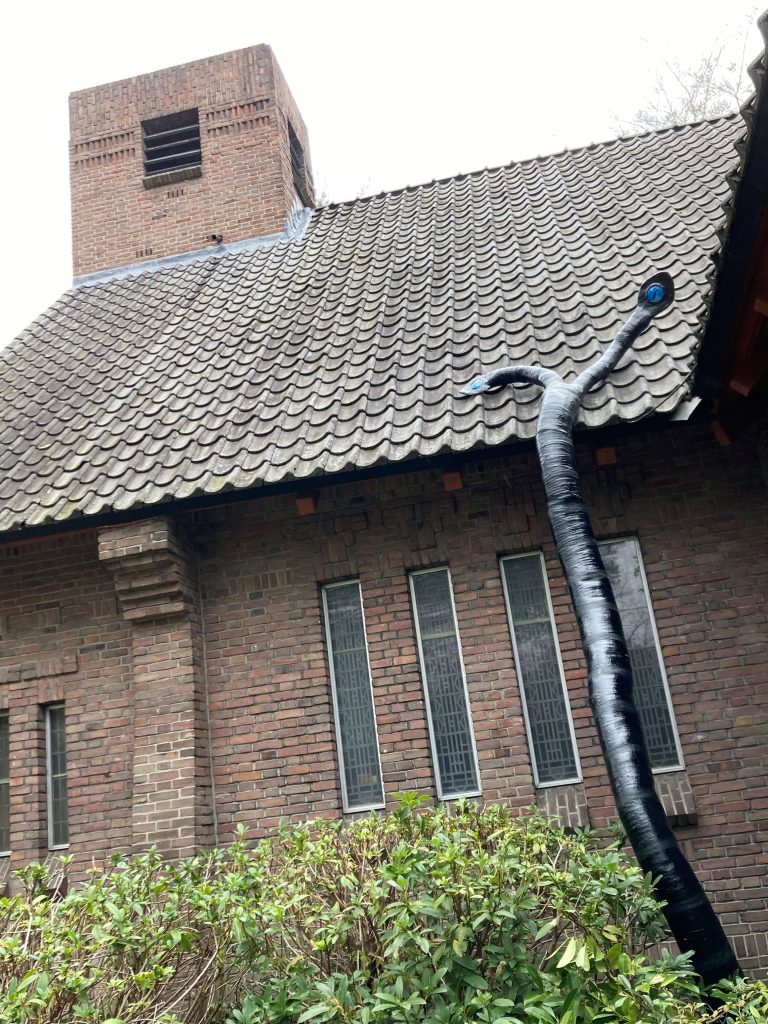Mycellium Conscius
Since April 28, this work of art has been on display at De Woudkapel, Beethovenlaan 21 in Bilthoven.
In short (under extended version)
During a trip through the German hills I saw a church tower lying in the sun between two trees in the valley. This tower was covered by a creature, somewhere between fungus, animal and God. The creature was enveloping the building, taking it over. It had eyes, consciousness. What was that, what was going on here? The image stuck with me and made me think.
I moved what I saw in this vision from that German roof to the roof at the Woudkapel.
I think the language of the vision is close to the language of dreams and mythology. We can therefore ask ourselves what we are looking at, as if we were looking at a dream or seeing a drawing in a myth. Who or what is this creature and what does is it up to?
Mycelium Conscius.
A new type of fungus seems to have appeared on our earth, the Mycelium Conscius, a sentient species of fungus. I saw it myself in a vision, during a car ride in the German hills. In a flash between the trees along the road. The creature lay on top of a church tower. It sat there unmoving, consuming the building like a carpet of mushrooms on a fallen tree. However, it had many eyes. On one side it radiated a completely primitive energy, on the other side it looked like a Deity. Grand, untouchable and awe-inspiring.
Once we arrived at the church, it turned out not to be real, but 'just' a vision. Something in me had projected this image onto the church tower in a flash. Had it been 'real', I now realize that it would have been of less significance than in a vision. The image stayed with me and I tried to hold on to it.
The ability to actually create this vision on a church building was of course a wonderful coincidence. I was able to pass on the prophecy from the vision.
I often wonder if my work isn't already done. In fact, yes, because I think everyone can determine for themselves what this prophecy means for him or her. However, this requires quite a bit of concentration and in this case I am also only a spectator of the vision. Now that the opening has taken place and I have had some response, I would like to elaborate further on what emerged.
I think it is a good idea to first consider fungi. If you were to divide the world into growth and division processes on the one hand, which we often call 'life', and decomposition processes, which we often call 'death', on the other, then the fungi are often more on the decomposition side. A tree falls and it does not stay there forever, because fungi in particular break down the tree into small particles, creating fertile soil again. The basis for new 'life'.
The most common reaction among members of De Woudkapel to the work (also the name of the church against which the work is located) was: “A scary creature is attacking our Woudkapel. Why?".
Let's take a look at that, also taking into account the situation that De Woudkapel finds itself in. The Woudkapel is a community of liberal Protestant origin. The number of members has decreased over the years and is aging rapidly and it is becoming increasingly difficult to find enough active volunteers to run the organisation. On the other hand, there is an extensive substantive program and every effort is made to develop new concepts and remain relevant in new ways.
This situation is not unique in the Netherlands, many (former) churches have similar problems.
What I find interesting in this context is that the creature seems to focus on the building. I would like to discuss this further, because it is not self-evident that the building plays such a central role in religion. In the Shinto faith, for example, a temporary structure is erected only for a ritual, after which it is burned again. The cycle is eternal, but not the building, therefore the Mycelium Conscius would not be interested in it, I think. In Christianity, the tradition arose (after several centuries) to express eternity in the building. The emphasis is on (in)finity rather than on the cyclical. Reincarnation also does not exist in Christianity, although there are voices that say that this concept was only removed since the 4the century has been deleted (approximately the period when The Devil made his appearance and Christianity itself transitioned from a sectarian to an institutional religion). Maybe the mycelium conscius asks us questions about the role of the building or more broadly: the institute. Both have a strong 'tenacious' character. What is a religion, what is a community without its building or without the institution? What fears does thinking about this arouse, what mental space does it create?
Not only churches, but also bridge associations, organizations such as Rotary and many other types of associations face a similar situation, where the extinction of the institutionally oriented generation seems to be accompanied by the demise of the institutions that organize connections in society. This breakdown continues, despite the recurring need for connection. There seems to be no way back, the institutions do not appeal to new generations.
We can also zoom out even further. Then we come to a subject that is perhaps the most difficult for Western people. We grow up in a world that is about making, obtaining and consuming things. Apparently we expect a lot from this. It's so obvious that we can no longer see it, like the fish that cannot see the water. We spend a lifetime talking about it. We live in a huge manufacturing machine. Our making machine is based on extracting raw materials from the earth. In fact, we are uncovering more and more of what was underneath. We don't really know what to do with it afterwards, it has only come to our attention for a few decades. This also stems from that belief in (in)finity. We want to get on with it. We're on our way somewhere.
In the mythology of many peoples, a connection is made between the health of the land and the (mental or moral) health of the people. The barren land is actually a metaphor for the barren mind.
Here I see a mythological creature emerging from the earth, which has started the work that fungi always do: breaking down. The ground becomes emptier and emptier, new nutritional elements are needed for a fertile earth, a fertile mind.
Mycelium in the spotlights
In recent years, fungi have received a lot of attention. One of the underlying reasons for this is that the legislation surrounding the psychoactive substances of magic mushrooms and related substances has been relaxed, especially in the US. A lot of research is being done into the psychiatric application of psychoactive substances, especially from fungi, such as mushrooms. It is becoming increasingly common among people in their thirties and forties to experiment with these substances. Unlike teenagers and people in their twenties, the approach is more focused on personal and spiritual development. Even in training and courses aimed at personal growth, you should no longer be surprised when you are to eat a medicinal plant .
In addition, a view is increasingly emerging that attributes a major role in history to psychoactive substances. To name two. The 'Stoned Ape' theory, which claims that humans actually emerged because the monkey developed greater consciousness by eating psychoactive fungi. Other theories attribute a major role to psychoactive substances in the religious rituals of the past. Particularly with the ancient Greeks.
Even now - when we seem to be a the dawn of the narrative worldview, of which the Enlightenment can be called the culmination - it is logical that our attention returns to the fungi, as they promise to cure us of life in logic and plans. Fungi that seem to represent a more earthly intelligence. In the context of this work of art, I am now also following a so-called microdosing treatment. I take a small amount of psychoactive substance (truffles from a psychedelic mushroom) every three days. The approach is to follow the treatment for a month.


